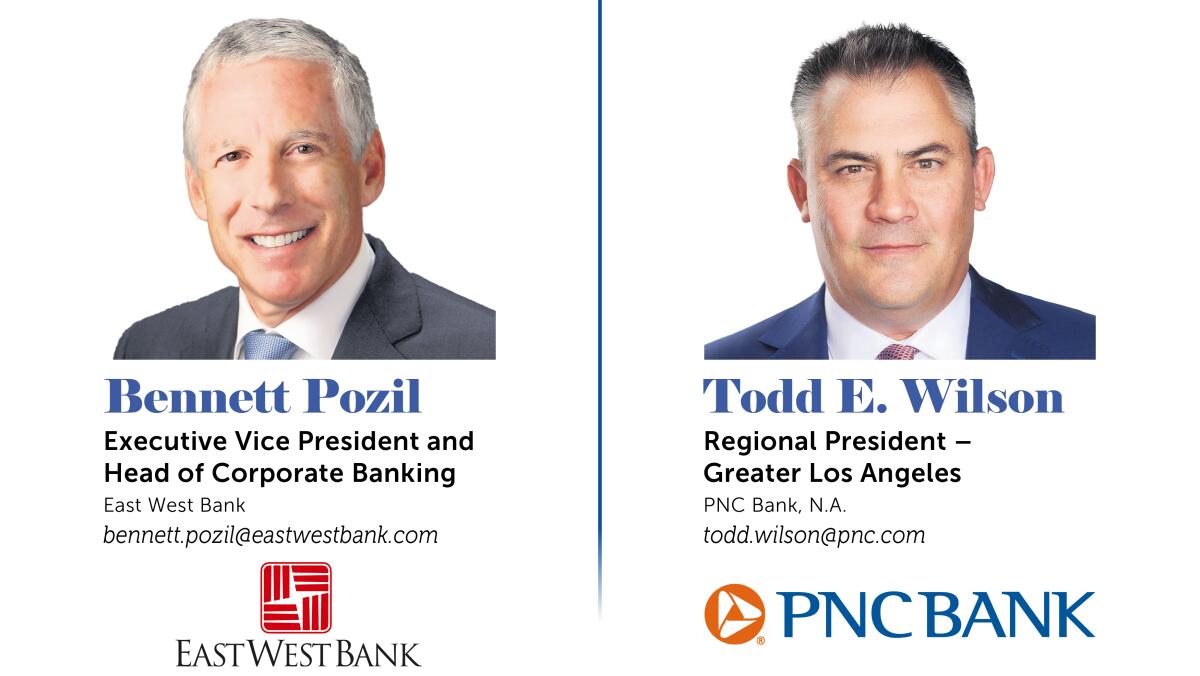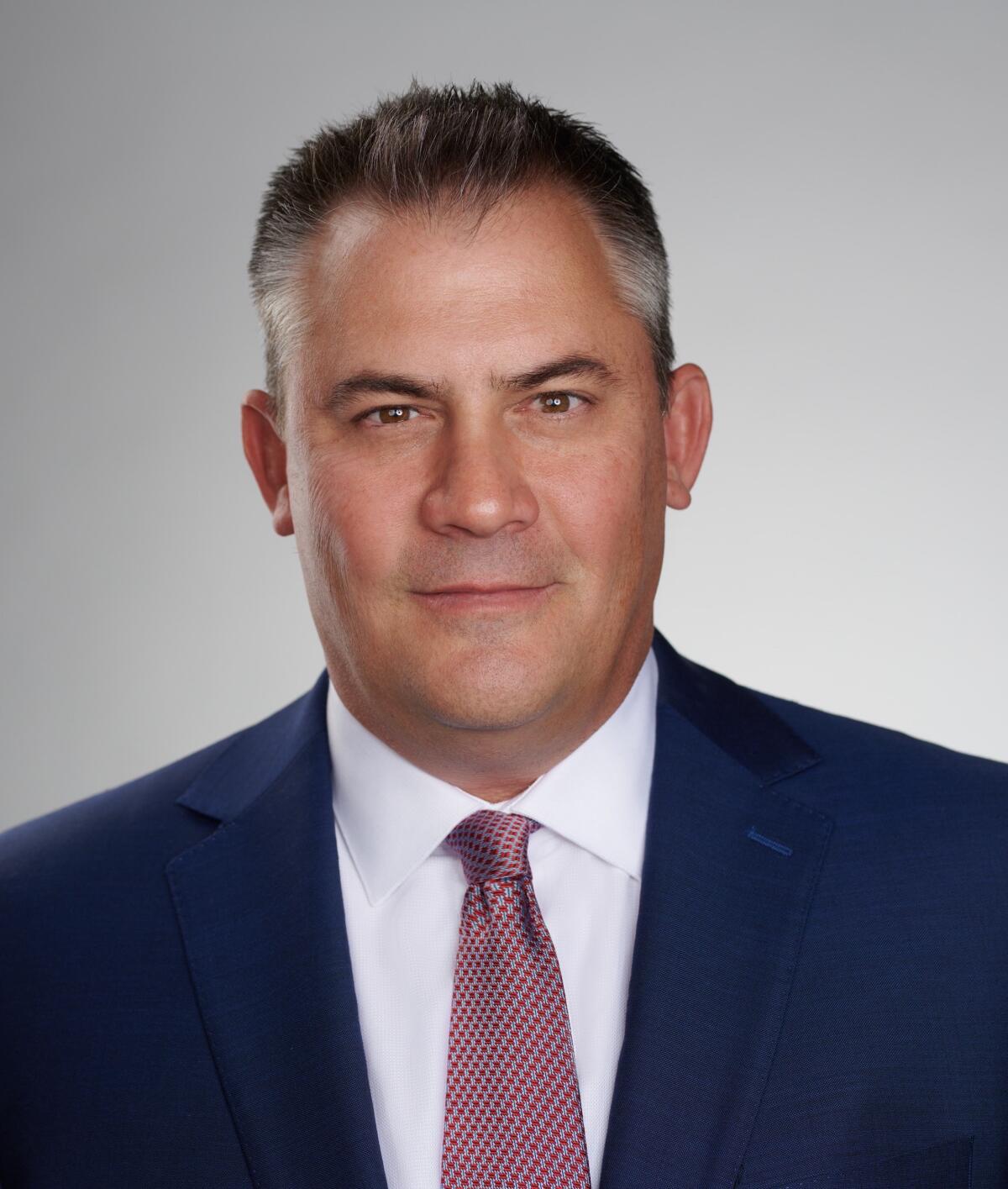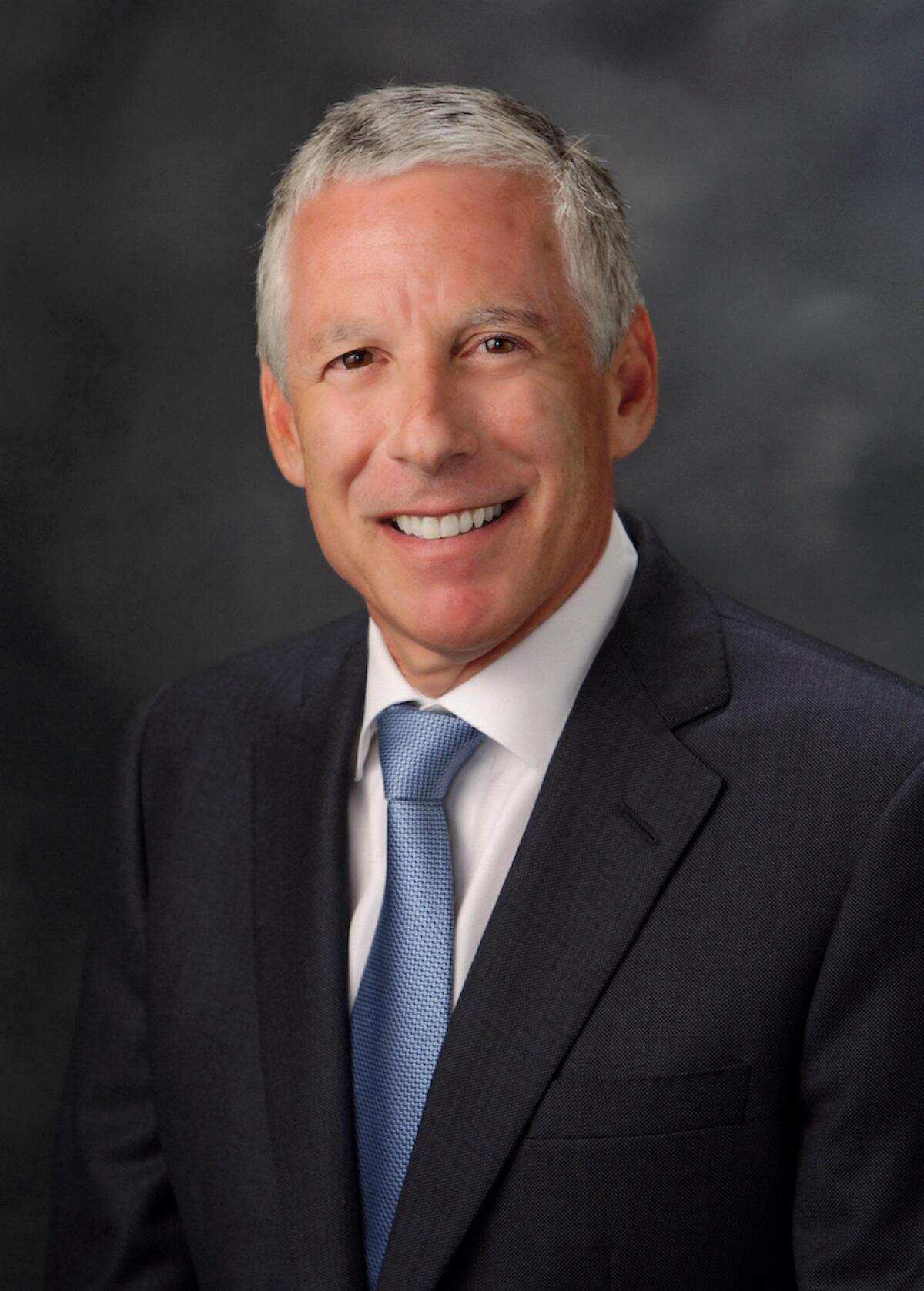Bennett Pozil and Todd E. Wilson Give Their 2022 Economic Forecast & Business Predictions

- Share via
The 2022 Economic Forecast & Business Predictions panel is produced by the L.A. Times B2B Publishing team in conjunction with East West Bank and PNC Bank, N.A.
The business landscape in 2021 was faced with complex challenges. The rollercoaster of the COVID-19 pandemic continued to force companies to further assess and in many cases make permanent changes to the way they do business and how they approach their relationships with customers, clients and employees. With a fair amount of uncertainty in the air for 2022, it’s challenging to know what’s coming next and how businesses in virtually all industries should prepare for the months and year ahead.
This Los Angeles Times B2B Publishing roundtable discussion is designed to provide unique insights into forward-looking business strategies for 2022. What new best practices should businesses be aware of this year? How is 2022 shaping up for international business? What supply chain management trends can we expect? For the answers, we turned to two of the region’s trusted advisors and experts, who graciously weighed in for a discussion and shared predictions and forecasts of what to expect.
Q: What advice would you give your clients for the coming year?

Todd E. Wilson, Regional President – Greater Los Angeles, PNC Bank, N.A.: The best advice we have for our clients, whether retail, PNC Private Bank affluent investor or a business owner, is to stay focused on your goals. It is tempting in challenging and difficult times to act on impulse. The common denominator for customers that achieve great success is their frequency of communication with their banker and their focus on long-term objectives. Another area we focus on when advising our clients is the need to keep pace with technology, with a particular emphasis on guarding against the potential for cybercrime. The adoption of technology and an increasingly disconnected workforce have made it easier for cybercrime to impact companies across the U.S. Drawing upon PNC’s own commitment and expertise in the security space, the bank regularly works alongside its clients to help them understand and prepare for their own cybersecurity risks.

Bennett Pozil, Executive Vice President and Head of Corporate Banking, East West Bank: Flexibility and resiliency remain paramount in 2022. The emergence of the Omicron variant and the ongoing tensions with China will likely continue to impact how businesses approach cross-border activity, which is a focus for us. Additionally, more regulatory changes are expected in both the U.S. and China. The Biden Administration has already stated that its 2022 priorities include creating a regulatory agenda for digital assets and fintech companies, increasing competition, and addressing climate change through new rules that will require risk analysis and disclosures. China has already started executing policies to stabilize the country’s economy and reverse the slowdown caused by a growing property crisis, weak domestic consumption, and COVID-19. To navigate these challenges, businesses will need to embrace a more flexible and resilient model and stay informed on the shifting regulatory environments in both countries.
“The adoption of technology and an increasingly disconnected workforce have made it easier for cybercrime to impact companies across the U.S.”
— – Todd E. Wilson
Q: What types of businesses will thrive during 2022?
Pozil: Businesses that thrived in 2021 will continue to do so in 2022 due to the pandemic, especially B2B, B2C, SaaS and eCommerce companies. However, based on current events, the sectors that will likely have the greatest opportunity for growth are clean energy and logistics. Clean energy remains a key priority for the U.S. and China, as both countries continue to implement policies to address the impacts of climate change. In 2021, the supply chain crisis spurred investment into logistics technology that aims to streamline operations and boost efficiency, which is likely to continue through this year.
Wilson: Success this year will look different for every business but we believe there is one common factor among those that will thrive - an ability to be flexible and adapt to new ways of working. The past two years have seen a complete transformation in where employees choose to work and in how they work. The willingness and ability to keep pace in a constantly changing environment will result in higher employee engagement. That, in turn, will translate to the ability to better serve customers and generate strong results.
“In 2021, the supply chain crisis spurred investment into logistics technology that aims to streamline operations and boost efficiency, which is likely to continue through this year.”
— – Bennett Pozil
Q: What market risks do you foresee for 2022 and how do you suggest clients mitigate them?
Pozil: Outsized inflation will likely be the biggest market risk for businesses in 2022. Supply chain and labor issues related to the pandemic have contributed to limited supply and higher prices. I expect that this supply and demand imbalance will wane, albeit slowly, this year. However, businesses should prepare for elevated inflation by taking careful consideration of their expenses, spending prudently, and making changes to ensure sustainable growth. Policy shifts are likely to happen this year to slow down inflation. Until then, businesses need to remain flexible and be ready to adjust as needed.
“Clearly, the labor market remains tight and the ‘great resignation’ of November is further evidence that the way in which people want to work has changed, not only today but for the long term.”
— – Todd E. Wilson
Q: In the bounce-back from the pandemic, how has the job market been affected?
Wilson: The competition for talent is greater than ever as we all focus on the recovery from the pandemic. PNC’s economists noted in their 2021 year-end economic report, the PNC National Economic Outlook, that while the headline November jobs number was weaker than expected, the underlying details were strong. They also said that there was an encouraging increase in the labor force in November and that strong job growth should continue throughout 2022. Clearly, the labor market remains tight and the “great resignation” of November is further evidence that the way in which people want to work has changed, not only today but for the long term. What we see is that the businesses best positioned for success are those that are willing to adapt and be flexible, whether that means enabling employees to work remotely or in a hybrid model.
Q: What trends can we expect from a supply chain management perspective?
Pozil: In 2022, supply chain disruptions remain likely due to strong demand and pandemic-related uncertainty. While China shut down certain regions and ports due to an increase of COVID-19 cases last year, I expect supply to improve this year, as overall infection rates continue to go down. Overall, the pandemic has increased the trend toward more global supply chains. However, due to ongoing U.S.-China trade tensions, more and more countries are developing policies to protect and diversify their supply base at home and in key areas, such as semiconductor chips and rare earth metals. This is leading to higher prices and lower demand for certain products. For these reasons, businesses are now investing in digital technologies that support supply chain management to help increase productivity and growth.
Q: What are the factors driving the M&A market?
Wilson: One key factor driving mergers and acquisitions is consolidation across several industries. The decision to grow through acquisition or seek a merger is about being strategic and determining the right decision for your company. Recognizing this, PNC supports customers through Harris Williams, our business dedicated to advising companies throughout their life cycle. We also are seeing more entrepreneurs talking with established companies about the potential for a merger or an acquisition, depending on the approach that best suits the business plan of each organization. We believe the uptick in these conversations has been fueled by the entrepreneurialism in Los Angeles combined with the greater access to capital among established companies, and we expect to see more of this in 2022.
“Due to ongoing U.S.-China trade tensions, more and more countries are developing policies to protect and diversify their supply base at home and in key areas, such as semiconductor chips and rare earth metals.”
— – Bennett Pozil
Q: What major developments do you foresee for U.S. trade policy in ‘22?
Pozil: U.S. trade policy may start to take shape in 2022, with a specific focus on realigning strategies toward China that protect American workers and businesses. Some potential actions include evaluating China’s performance in owning up to its commitment to certain U.S. industries and creating a targeted tariff exclusion process. During a highly anticipated meeting between President Biden and President Xi late last year, both leaders pledged further cooperation on bilateral relations and found common ground in addressing issues related to climate change and armed conflict prevention. While this is a step forward in normalizing our country’s relationship with China, more will need to be done to ensure better relations now and into the future. A protracted trade war between the world’s two largest economies will only do more harm than good in the long run and could cause more instability during a period of ongoing uncertainty.
Q: How do you think the U.S.-China trade policy will impact the relationship between Hollywood and China?
Pozil: The current state of U.S.-China bilateral relations – against the backdrop of a global pandemic – has driven China further inward. Even before the outbreak, there has been an effort to limit the influence of American pop culture within the country. This “decoupling” by the Chinese film industry with Hollywood will likely continue, as the country shifts its focus from being interdependent to self-reliant across various industries. This means fewer Hollywood movies will get release dates in China. The Hollywood-China relationship is entering a new era, where it is no longer immune to the political vagaries between Beijing and Washington. The main question here is how Hollywood will navigate this new status quo going forward.
Q: How can the U.S. strike the right balance with trade and investment partners in China?
Pozil: Looking forward, U.S. policymakers will need to take a reasoned approach toward new proposals to regulate economic ties with China. Striking the right balance will not be easy, but it is needed as American workers benefit from trade and investment with China. According to the U.S.-China Business Council, exports to China support more than 1.2 million U.S. jobs. Additionally, U.S. businesses’ presence in China drives growth, revenue, and innovation, boosting jobs back home. Despite the rhetoric, the bulk of U.S.-China economic engagement is irrelevant to national security concerns. In sectors where there may be potential risks, the U.S. has tools to mitigate these concerns. Dealing with what risks do exist requires a scalpel, not a sledgehammer.
Q: How can businesses improve their financial literacy?
Wilson: From a corporate and operational perspective, improving financial literacy is a challenge for almost any business. That challenge can encompass the need to identify and address potential inefficiencies to improve revenue, recognizing that investments in technology solutions can help automate tasks like accounts payable and receivables, and more. This is where having a trusted relationship with a team that includes a banker, accountant and attorney is a differentiator. The key is ongoing communication and sharing of information with that team. It is through those conversations that we often help businesses uncover opportunities to improve their financial literacy and further their success, helping to ensure longterm growth. There is also another critical component businesses need to consider - their employees. This is why the PNC Organizational Financial Wellness (OFW) Program was formed. Through OFW, PNC can collaborate with a business’ human resources executive or dedicated benefits manager to design a custom program, created with an understanding of their employees’ financial wellness needs. OFW solutions can include everything from a Bank-At-Work program and Health Savings Accounts to online financial education accounts, Retirement Plans Services, and more. The goal is to help business owners deliver solutions employees desire and help them gain financial confidence and security, services to attract and retain employees, and further improve their employee engagement and job satisfaction. Ultimately, it is not about delivering a single solution. This is where the strength and capabilities of a national Main Street bank, with a local focus, can provide businesses in our region with the resources they need to achieve success by addressing more holistically the issue of financial literacy.




